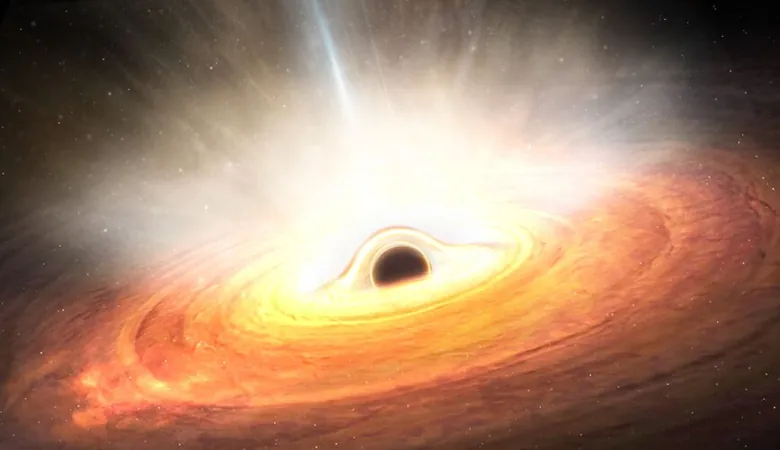
The Astonishing Origins of Supermassive Black Holes: Did They Hold an Early Advantage?
2024-11-11
Author: Sarah
How Did SMBHs Become So Massive, So Quickly?
Black holes of varying sizes, from stellar to supermassive, have long intrigued scientists. While we understand that massive stars collapse into stellar-mass black holes during their life cycles, and that these smaller black holes can merge to form larger ones—evidence of this has even come from gravitational wave detections—questions remain about the rapid formation of SMBHs.
The crux of the problem lies in the timeline of the early universe. Current theories suggest that not enough time existed for stellar-mass black holes to coalesce into the gargantuan SMBHs we observe today. Yet, JWST has identified quasars powered by black holes ranging from 1 to 10 billion solar masses, appearing less than 700 million years post-Big Bang—a find that has sent shockwaves through existing astrophysical paradigms.
A team of researchers, led by Francesco Ziparo from the Scuola Normale Superiore di Pisa in Italy, has stepped forward with a compelling hypothesis. Their research, titled "Primordial black holes as supermassive black hole seeds," seeks to bridge the knowledge gap surrounding the origin of these titanic black holes.
The Four Categories of Black Holes
Traditionally, black holes are classified into three main types based on their mass:
1. **Stellar-mass black holes**, ranging from five solar masses to several tens of solar masses.
2. **Intermediate-mass black holes (IMBHs)**, with masses scaling from around one hundred to one hundred thousand solar masses.
3. **Supermassive black holes (SMBHs)**, which can possess masses that reach hundreds of thousands to billions of solar masses.
Though IMBHs could theoretically link stellar-mass black holes and SMBHs, their existence remains largely unproven. Enter **Primordial Black Holes (PBHs)**—a theoretical fourth category that some researchers believe could explain the early emergence of SMBHs. These PBHs could have formed under the extreme conditions that existed in the universe's infancy, possibly stemming from the direct collapse of dense pockets of subatomic matter.
A Novel Approach to Black Hole Formation
The study posits that PBHs clustered together in high-density regions during the universe's early stages, potentially creating seeds for SMBH formation. This clustering mechanism aligns with the formation of dark matter halos—regions in space dominated by dark matter. As these halos expand, baryonic matter (the normal matter we observe around us) cools and settles into these potential wells, primarily around 30 solar masses.
The researchers argue that as PBHs accrete matter, they lose angular momentum and eventually form a dense core. Through these dynamics, coupled with dark matter interactions, the growth of SMBHs can occur more rapidly than previously understood.
What Lies Ahead?
One of the most exciting prospects of this model is its testability. The authors suggest that during the runaway phase of PBH formation, ample gravitational waves would be emitted during PBH mergers. Future observations from the proposed Einstein Telescope could validate this model, capturing gravitational waves and potentially offering fresh insights into early cosmic conditions.
The Einstein Telescope aims to augment our understanding by observing gravitational waves with increased sensitivity, enabling a comprehensive exploration of stellar and intermediate-mass black holes throughout cosmic history.
As we peel back the layers surrounding SMBHs, we uncover more than just the mechanics of their formation; we start to question the very fabric of our universe. These colossal entities play a crucial role in shaping the cosmos—affecting the distribution of matter on a grand scale and shaping the galaxy structures we observe today.
The revelation that SMBHs formed much earlier than previously anticipated serves as a testament to the many mysteries that still lie hidden in the cosmos. As we continue our exploration, one thing is certain: the universe, with all its complexities and wonders, has far more secrets to unveil!




 Brasil (PT)
Brasil (PT)
 Canada (EN)
Canada (EN)
 Chile (ES)
Chile (ES)
 España (ES)
España (ES)
 France (FR)
France (FR)
 Hong Kong (EN)
Hong Kong (EN)
 Italia (IT)
Italia (IT)
 日本 (JA)
日本 (JA)
 Magyarország (HU)
Magyarország (HU)
 Norge (NO)
Norge (NO)
 Polska (PL)
Polska (PL)
 Schweiz (DE)
Schweiz (DE)
 Singapore (EN)
Singapore (EN)
 Sverige (SV)
Sverige (SV)
 Suomi (FI)
Suomi (FI)
 Türkiye (TR)
Türkiye (TR)